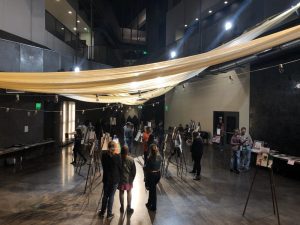During every period of the Language Arts class we observed at Mitchell High School last Friday, the school’s negative reputation in the Colorado Springs community was brought up as a topic of discussion– both by the teacher, Rob Lessig, and the students themselves. Mitchell’s low test scores mean that the state has them on watch, and a video of a student fight recently received a disproportionate amount of local media attention. I bring up these negative narratives not to give them any more time and space than they have already occupied in the Colorado Springs discourse around education, but to make explicit the message that students and teachers at Mitchell High School constantly receive about themselves: that they are failing. But, as M.R Duncan-Andrade and Ernest Morrell point out in their book The Art of Critical Pedagogy: Possibilities for moving from theory to practice in urban schools (which, by the way, has been a veritable bible of teaching practices for social justice transformation that I am cursing myself for renting from the bookstore instead of buying), urban schools fail in a system that is set up for their failure. Though Colorado Springs is not exactly a metropolis, we discussed in class how “urban” is often used as a whispered stand-in to describe any school, like Mitchell, that has a high population of students of color and students from low-income households. Duncan-Andrade and Morrell stress the urgent need to reform the “Politics and Economics of Failure” on the broad level of policy; in short, they argue that our education system is constructed so that some schools must fail, that resources are allocated inequitably to schools deemed failing, and that practices which measure failure and police students’ behavior and “intellect” such as standardized testing and the school-to-prison pipeline are biased against students of color. But they acknowledge that upper-level change won’t happen for a while, and that on the ground, right now, urban schools, teachers, and students themselves are involved in actively constructing counter-narratives to the grand narratives told about them by an inherently inequitable system.
This work of creating counter-narratives was exactly what we saw in action at Mitchell High School. We got the opportunity to participate for one day in a project led by CC student Jubilee Hernandez, where students created art pieces representing various forms of oppression that were auctioned off that night at Cornerstone Arts Center to benefit a scholarship (previously set up by a group of students at Mitchell) for DACA students. The juniors and seniors in the class were practicing sharing their artist statements, which we were lucky enough to get to hear. Students created pieces representing mental health issues, socioeconomic disparities, the treatment of undocumented immigrants, the sexism of their school dress codes, the impacts of labeling and judgement, and more, while many directly took on the education system which they felt has served them inequitably. They were angry at the fact that standardized testing practices are racist and inaccurate measures of anything, much less intelligence, and that testing was narrowing their school’s curriculum and impeding their creativity and self expression. They were proud to be students at Mitchell, despite their frustration with their school’s lack of resources, and knew that the grand narratives told about them were wrong.

Last year, I was lucky enough to witness another example of change-making at Mitchell High School. I was involved in the Public Achievement program, where Colorado College students coach high schoolers as they create projects that address injustices in their community and world, but outside of Public Achievement, many seniors that year created capstone projects for essentially the same purpose. At an end-of-year event meant to showcase their hard work and build bridges between students and policy-makers, students presented their projects to members of the Colorado Springs Community including representatives from the school board. It was one of these groups that set up the aforementioned Dreamers scholarship, while other groups proposed projects tackling environmental issues, sex trafficking and mental heath awareness, even establishing free childcare and mentorship programs at their school. Mitchell also serves as a Community School and an essential local resource, with a food pantry and health clinic that’s often used as a place where students in the school’s Public Health program can get experience. All of this is to say that Mitchell students are actively involved in their community- a community that often does not have very positive things to say about them. The system certainly isn’t perfect, and the function of Mitchell High School is influenced and impeded by resource allocation and other forces out of their control, but there’s a lot of positive things to say about Mitchell and its students, things which they know, and live, on a daily basis. I was really humbled by this opportunity to have just a tiny entry point into the work that’s happening at this school, and to continue to learn from the counter-narratives they tell as a response to a system designed for their failure.